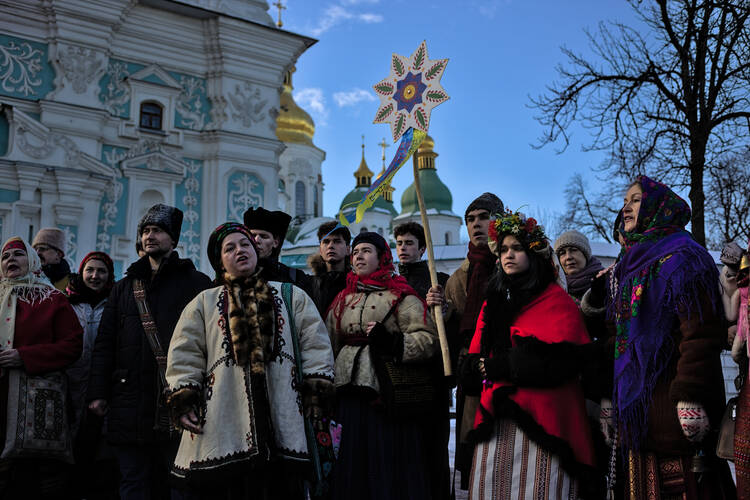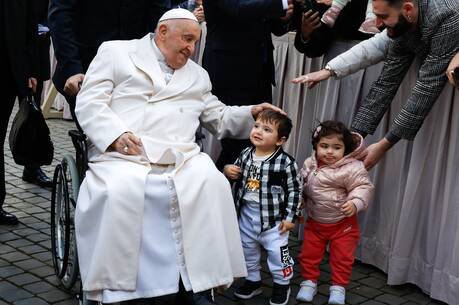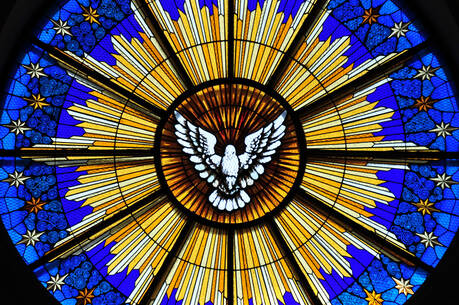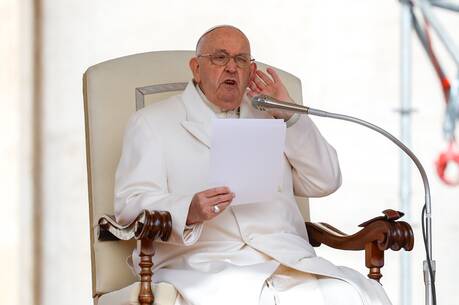On Dec. 4, Carnegie Hall will host a holiday celebration to benefit Ukraine. Compositions by Leonard Bernstein, George Gershwin, Eric Whitacre and others will be performed by choral groups from North America and Europe in honor of the 100th anniversary of the Christmas song “Carol of the Bells.” (If you can’t quite place it, “Carol of the Bells” is that earworm-y Christmas carol we hear in a million commercials around the holidays, usually featuring bells playing the same four notes over and over at high speed. Google it and you’ll know it right away.) Proceeds from the event, called Notes From Ukraine, will benefit the United24 campaign to rebuild that nation.
How does a Christmas carol rate a party at Carnegie Hall? And how is a song used in 100 holiday ads somehow connected to Ukraine? It turns out every carol that we sing at Christmas has a story behind it, some inspiring, some strange. Each week in Advent on the America podcast “Hark!” we explore the fascinating stories behind our favorite Christmas songs.
In the case of “Carol of the Bells,” that tale involves two music teachers, 76 choir singers, a political revolution and, believe it or not, a murder.
The Music Teacher
Mykola Dmytrovych Leontovych was supposed to be a priest. Like his father, his grandfather and later his younger brother, Leontovych attended the Kamianets-Podilskyi Theological Seminary in what is today western Ukraine but was then part of the Russian Empire, to learn the family trade. He had also grown up around music; his father played a half-dozen instruments and directed Leontovych’s school choir, and his mother was a singer. Leontovych, too, played several instruments, sang and wrote choral arrangements for the seminary. When the choir director died, the seminary put him in charge.
So when it came time to graduate in 1899 and start a career, Leontovych followed a different set of family footsteps and became a music teacher, arranger and composer. Although he walked away from a life in the priesthood, he did not leave his faith behind. In fact, he would go on to craft the first Eastern Orthodox Ukrainian liturgy written in the vernacular.
It turns out every carol that we sing at Christmas has a story behind it, some inspiring, some strange.
Ukraine has a rich history of folk songs. Even before the advent of Christianity they were a part of everyday life, a way of blessing one’s neighbors or worshiping ancient gods, with sometimes quite complex multi-part harmonies sung a capella.
Leontovych believed in the power of song to bolster people’s spirits. Everywhere he worked he created choirs. During strikes and protests against Czar Nicholas II’s leadership in 1905, Leontovych organized a choir of workers to perform at meetings. They would sing arrangements of Ukrainian, Jewish, Armenian, Polish and Russian folk songs. It got him into trouble. Eventually he was sent back to his home province in what is now central Ukraine.
In private Leontovych created choral arrangements for these ancient folk songs. But he was a perfectionist and could spend years working on a single arrangement before he let anyone see it. It was not until 1914 that he finally agreed to allow any of his arrangements to be performed.
One such song was a simple four-note melody called “Shchedryk,” or “Bountiful Evening.” In the song a swallow, whose yearly return to Ukraine signals the break of spring, invites the listener to look out on their property and see the prosperity that spring has brought. “Come out, come out, O master,/ look at the sheep pen,” the singers extolled. “There the ewes have given birth/ and the lambkins have been born./ Your goods [livestock] are great, you will have a lot of money by selling them.”
Ukraine had many folk songs like this celebrating the birth of a new year. But Leontovych’s arrangement had a unique driving energy; the song somehow seemed to dance among elements of the choir. The Ukrainian conductor Oleksander Koshyts liked it so much he convinced Leontovych to let him produce it in Kyiv in 1916. It was well received; and three years later, when Koshyts organized the first-ever international tour of a Ukrainian choir, he made “Shchedryk” the choir’s signature piece. Through Koshyts, Leontovych’s melody would eventually find its way to the United States, and unexpectedly, to a whole new setting at Christmas.
Singing for Independence
But first the Ukrainian people would come to know both tremendous hope and cruel loss. In 1919, Symon Petliura had a problem. Two years earlier, after the Bolsheviks overthrew the Russian Romanov monarchy, he had become president of a sovereign Ukrainian nation, the Ukrainian People’s Republic. But its existence remained fragile; the Bolsheviks refused to recognize the country’s independence. Meanwhile, in the aftermath of World War I, the world’s great powers were gathering in Paris to determine the new borders of Europe.
A former journalist, Petliura saw that he needed a way to generate international support for his fledgling state. According to the Ukrainian government’s website, Petliura had an idea while listening to another work from Leontovych at a concert: to create a choir of the country’s best voices and send them on an international tour. They would “sing for the independence of Ukraine.”
Over the next two years the Ukrainian National Chorus performed hundreds of concerts in 45 cities in 10 European countries, dressed in tuxedos and gowns, signaling to the world that the Ukrainian People’s Republic was a modern country. Everywhere the choir went, they passed out brochures about their nation and sang what would become the country’s national anthem. Their efforts were a huge success. “Ukraine’s cultural maturity must become the legitimation of its political independence in the world,” the Austrian press wrote. In France, people dubbed Leontovych the Ukrainian Bach; his “Shchedryk” regularly brought the house down.
By 1921 the country that the Ukrainian National Chorus was promoting no longer existed.
But by 1921 the country that the Ukrainian National Chorus was promoting no longer existed. The Bolsheviks had completely overrun the state. They sent in thousands of secret police to root out “counter-revolutionaries,” which in practice meant not only political opponents but intellectuals, religious leaders and members of the bourgeoisie.
One of their targets was Mykola Leontovych. In a cruel twist on the Nativity story, a man approached Leontovych’s parents while Leontovych was visiting them during the Eastern Orthodox celebration of Christmas, wondering if they might have a room for him for the night. They opened their doors to the stranger, who spent the night sleeping in the same room as their son. At dawn the agent pulled out a rifle and shot him. Leontovych was later declared a martyr of the Eastern Orthodox Ukrainian Church.
The Hit in Our Repertoire
Though the Ukrainian People’s Republic no longer existed, the tour of the Ukrainian National Chorus did not end. The famed American impresario Max Rabinoff, who was originally from Russia, heard the choir perform in Paris and organized the continuation of their tour from 1922 to 1924 through seven countries of the Americas. The choir would do 400 concerts in 150 cities, including 115 cities in 36 states in the United States. They also recorded a number of their songs, including “Shchedryk.” As in Europe, everywhere the choir went people called for encores of Leontovych’s song. In his memoir Koshyts would write, “Shchedryk was the real hit in our repertoire.”
On Oct. 5, 1922, the choir performed at Carnegie Hall. The story is often told that in the crowd that autumn night was a 20-year-old music student named Peter J. Wilhousky. Born in Passaic, N.J., he, too, came from an Eastern European family passionate about music. He and all seven of his siblings had attended the Russian Cathedral Choir School in New York.
After his graduation from the Damrosch Institute of Musical Arts (which would later become the Juilliard School), he also became a well-known and successful choir director and arranger of music. The Harvard geologist and writer Stephen Jay Gould was a high school student in the chorus that Wilhousky created and managed. In a 1988 remembrance, Gould recalls Wilhousky’s generosity: “He was one of the finest choral conductors in America, yet he chose to spend every Saturday morning with high-school kids.” He also remembers Wilhousky’s perfectionism and the impact it had on him: “His only rule, tacit but pervasive, proclaimed: ‘No compromises,’” Gould wrote. “The idea, however, is infectious. As I worked with Wilhousky, I slowly personalized the dream that excellence in one activity might be extended to become the pattern, or at least the goal, of an actual life.”
After the radio show performance, Wilhousky received so many requests for the music that he published it, in 1936, under the title “Carol of the Bells. Ukrainian Carol.”
Among his many jobs, Wilhousky made choral arrangements for Arturo Toscanini’s NBC Symphony Orchestra radio broadcasts. And there came a moment, according to a letter that Wilhousky sent to the Ukrainian musicologist Roman Savytsky, when he found himself in need of a short number to fill out a program starring a high school choir. Contrary to the legend that he heard the original concert at Carnegie Hall, Wilhousky tells Saytsky in the letter that he had only recently heard “Shchedryk” performed.
Though he had a copy of the music, there was no way his students were going to be able to sing the song in Ukrainian. The song reminded him of bells, so he set out to write new lyrics along those lines. “Hark! How the bells,” the song begins, and in three verses imagines bells pealing all across the land, announcing “Christmas is here/ bringing good cheer.”
After the radio show performance, Wilhousky received so many requests for the music that he published it, in 1936, under the title “Carol of the Bells. Ukrainian Carol,” with attribution to himself and Leontovych.
In music, an ostinato is a phrase—a set of notes—that gets passed around among different instruments. Leontovych and Wilhousky never knew each other, perhaps never even knew anything about one another. Yet their lives, like an ostinato, echo with similarities. So, too, did their hopes for “Shchedryk.” “Throw cares away,” Wilhouksy writes, to an audience enduring the Great Depression. “Bountiful, bountiful,” Leontovych’s swallow promises listeners at the conclusion of “Shchedryk,” at a time when Ukrainians wondered if they would ever be able to have a nation of their own.
If you visit the website for the nation of Ukraine, you will find a statue of a man holding a cross standing high above the Dnipro River. The man is Volodymyr the Great, otherwise known as St. Volodymyr, who first consolidated the region into a state of its own and made it a Christian nation. There is snow on the statue and the trees around it, but that has nothing to do with the winter season we are approaching. “On February 24, 2022,” the homepage reads, “The ordinary life in Ukraine stopped…. Ukrainians ‘froze’ at the end of winter on that terrifying February morning.”
And spring, the site goes on, “has not come to Ukraine yet.”
No doubt we will hear “Carol of the Bells” in our parishes this year, and on the radio, and probably in a million commercials, too. Though the words we hear will speak of bells, perhaps as we listen we can cast a thought back to this beautiful, haunting song’s origins, and send the people of Ukraine our prayers that they may soon know spring, new life and peace.
For more about the origins of “Carol of the Bells” and other Christmas carols, listen to America's podcast “Hark!”








